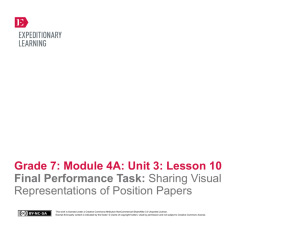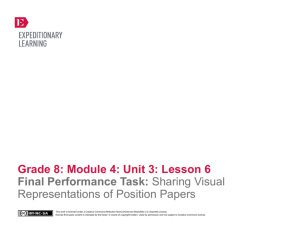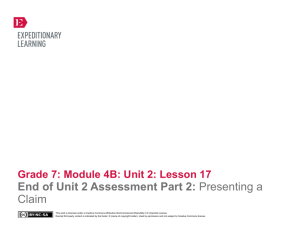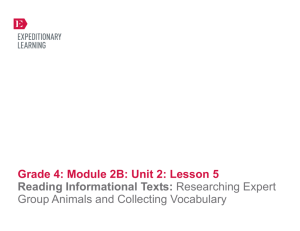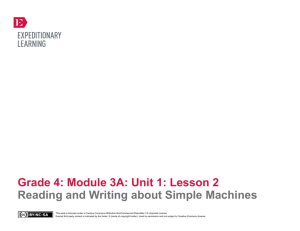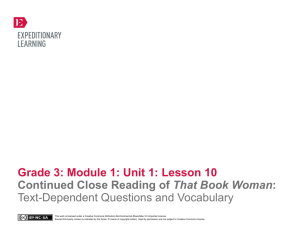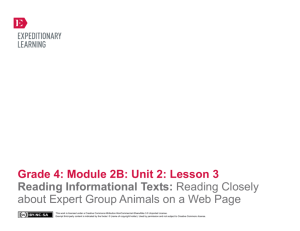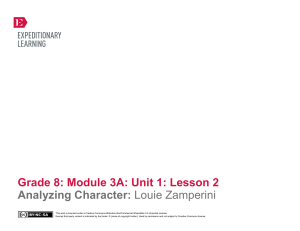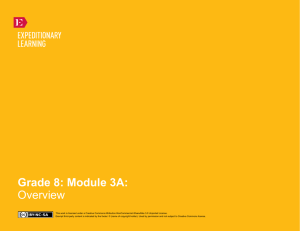Grade 7 ELA: Unit 3 Assessment & Independent Reading Review
advertisement
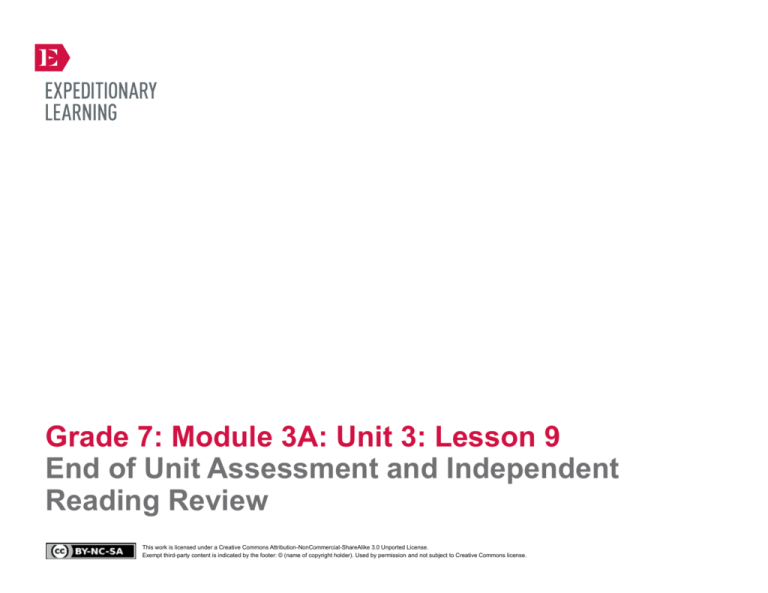
Grade 7: Module 3A: Unit 3: Lesson 9 End of Unit Assessment and Independent Reading Review This work is licensed under a Creative Commons Attribution-NonCommercial-ShareAlike 3.0 Unported License. Exempt third-party content is indicated by the footer: © (name of copyright holder). Used by permission and not subject to Creative Commons license. GRADE 7: MODULE 3A: UNIT 3: LESSON 9 End of Unit Assessment and Independent Reading Review Long-Term Targets Addressed (Based on NYSP12 ELA CCLS) I can write narrative texts about real or imagined experiences using relevant details and event sequences that make sense. (W.7.3) I can read grade-level literary texts proficiently and independently. (RL.7.10) I can use correct grammar and usage when writing or speaking. (L.1) I can use correct capitalization, punctuation, and spelling to send a clear message to my reader. (L.2) I can express ideas with precision. (L.3) Supporting Learning Targets Ongoing Assessment • I can recognize coordinating adjectives. • End of Unit 3 Assessment: Second draft of Storyboards for the Children’s Book • I can illustrate my children’s book in an effective and interesting way. • End of Unit 3 Assessment: Self Assessment of My Draft Storyboard • Independent reading assessment Created by Expeditionary Learning, on behalf of Public Consulting Group, Inc. © Public Consulting Group, Inc., with a perpetual license granted to Expeditionary Learning Outward Bound, Inc. NYS Common Core ELA Curriculum • G7:M3A:U3:L9 • November 2013 • 1 GRADE 7: MODULE 3A: UNIT 3: LESSON 9 End of Unit Assessment and Independent Reading Review Agenda Teaching Notes 1. Opening • In this lesson, students write book reviews for their independent reading books. See two separate standalone documents on EngageNY.org: The Importance of Increasing the Volume of Reading, and Launching Independent Reading in Grades 6–8: Sample Plan. Together these documents provide the rationale and practical guidance for a robust independent reading program A. Entry Task: Using Commas with Adjectives (5 minutes) 2. Work Time A. Writing a Book Review (25 minutes) B. Illustrating Your Book (12 minutes) 3. Closing and Assessment A. Handing in Storyboards for End of Unit Assessment (3 minute) 4. Homework A. Work on illustrating your children’s book. You will write the final draft of the text in the next lesson, but you may work on your art at home. • In this lesson, students also work on their children’s book illustrations. Consult with the art teacher in you school as you decide how best to guide students to be successful with this portion of the children’s book (see Unit 3 Overview and Lesson 8 Teaching Notes). Although some students may be ready to work on their final illustrations, many will not. Note that the bulk of illustrating their children’s book will be done outside of class. You may consider giving the introductory lesson of the next module or launching the next independent reading project to give the students more time to work on their illustrations at home. • In lieu of giving the whole class work time, consider asking one of your more artistic students to do a short mini lesson on illustrating techniques or to share a model illustration during Work Time B. If you do so, be sure you still hand out the cardstock or alternate material so the students can work on their illustrations at home. Remind them the final text will also go on cardstock but they will be writing that final text after you have given them feedback. • Today, as their End of Unit 3 Assessment, students turn in a packet of work that includes their second draft of their Storyboard, plus related materials: their first draft, the rubric, a self-assessment, and their I Heart Revisions worksheet. Together these function as their End of Unit 3 Assessment. (See student direction on the End of Unit 3 Assessment: Self Assessment of My Storyboard, in supporting materials). You may want to have this packet include the Peer Editing Checklist: First Draft and the My Children’s Book Plan as well. This way you can see students’ progress through the different stages of this project. • Between Lesson 9 and Lesson 10, assess students’ second draft storyboards based on the rubric (from Lesson 8). Consider this a formative assessment. Your feedback will help the students as they write the final draft of the text onto the actual children’s book pages in Lesson 10. This is the first time you will give formal feedback on the students’ children’s books. Use this as an opportunity to identify students who may benefit from doing another round of revisions before they turn their book in to be assessed in the performance task. Consider extending the deadline for those students. Created by Expeditionary Learning, on behalf of Public Consulting Group, Inc. © Public Consulting Group, Inc., with a perpetual license granted to Expeditionary Learning Outward Bound, Inc. NYS Common Core ELA Curriculum • G7:M3A:U3:L9 • November 2013 • 2 GRADE 7: MODULE 3A: UNIT 3: LESSON 9 End of Unit Assessment and Independent Reading Review Agenda (continued) Teaching Notes (continued) • In Lesson 10, students will react to your feedback and write the final drafts of their stories. If this timeline is insufficient, consider launching the students’ next independent reading project before you teach Lesson 10 to give yourself more time to give feedback. • In this lesson, students briefly learn about coordinating adjectives. • In advance: Decide in which form students will publish their book review and create a model in that form. The stand-alone document has a student guide for writing a book review that you may find useful. Consider giving an oral book review (see Unit 3 Overview for more suggestions). • In advance: Obtain cardstock for the students to begin illustrating their final pages. • Post: Learning targets. Lesson Vocabulary Materials coordinating adjectives • Entry Task: Using Commas with Adjectives (one per student) • Document camera • Entry Task: Using Commas with Adjectives Answer Key (one to display) • Model book review (one per student; new; teacher created in the form students will use) • Reader’s Review worksheet (optional; from separate stand-alone document on EngageNY.org: Launching Independent Reading in Grades 6–8: Sample Plan) • Children’s Book Storyboards (from Lesson 5) • Cardstock, or alternate material for constructing the final draft of the children’s book pages (six or more pieces per student) • Ladder to Success anchor chart (from Lesson 3) • End of Unit 3 Assessment: Self-Assessment of My Draft Storyboard • Entry Task: Looking at the Rubric (from Lesson 8) • I Heart Revisions worksheet (from Lesson 5) • My Children’s Book Plan (optional; from Lesson 3) • Peer Editing Checklist: First Draft (optional; from Lesson 6) Created by Expeditionary Learning, on behalf of Public Consulting Group, Inc. © Public Consulting Group, Inc., with a perpetual license granted to Expeditionary Learning Outward Bound, Inc. NYS Common Core ELA Curriculum • G7:M3A:U3:L9 • November 2013 • 3 GRADE 7: MODULE 3A: UNIT 3: LESSON 9 End of Unit Assessment and Independent Reading Review Meeting Students’ Needs Opening A. Entry Task: Using Commas with Adjectives (5 minutes) • Distribute the Entry Task: Using Commas with Adjectives. Explain that this is a quick writing rule you’d like students to remember because it will come up in their writing. Instruct them to work on it individually. • After a few minutes, direct students’ attention to the document camera and post the Entry Task: Using Commas with Adjectives Answer Key and ask students to assess how well they did. • Discuss the rule of coordinating adjectives. Explain that when two of the same type of adjective are together (like “sweet” and “frosty”—both describing how something tastes), they need to be separated by a comma. But when two different types of adjectives are together (like “thick” and “cotton”—“thick” is describing how something feels, while “cotton” is describing the material it’s made out of), they are not separated by a comma. An easy way to test whether adjectives are the same “type” is to reverse their order or insert the word “and.” If the sentence still sounds right, they are probably coordinating adjectives. Created by Expeditionary Learning, on behalf of Public Consulting Group, Inc. © Public Consulting Group, Inc., with a perpetual license granted to Expeditionary Learning Outward Bound, Inc. NYS Common Core ELA Curriculum • G7:M3A:U3:L9 • November 2013 • 4 GRADE 7: MODULE 3A: UNIT 3: LESSON 9 End of Unit Assessment and Independent Reading Review Work Time Meeting Students’ Needs A. Writing a Book Review (25 minutes) • Congratulate students on their work with independent reading. If possible, share data about how many books students have read or how many of them met their reading goals. • Providing models of expected work supports all students, especially challenged learners. • Tell students that they are experts in recommending their books to classmates: They know the books and they know their classmates. Today you will begin a process that will eventually build a big collection of book recommendations, so that students can figure out what books they want to read by asking the experts: other teenagers who have read those books. • Distribute and display the model book review in the form you have chosen for students to use to publish their book reviews. Read it aloud as students follow along silently. Ask: * “What do you notice about this?” * “What did the author say about the book? What didn’t she say?” • Tell students that now they will write a review of their independent reading book. Consider which scaffolds will help your students be successful, and use some or all of the following: – Turn and talk: Give a 1-minute oral review of your book. – Reader’s Review worksheet (from the separate EngageNY.org document) – Another graphic organizer – A rubric you plan to use to assess the reviews • Give students the remainder of the time to work individually. Confer with them as needed. Depending on your class and the format of the book review, some students may need to complete their reviews for homework. Created by Expeditionary Learning, on behalf of Public Consulting Group, Inc. © Public Consulting Group, Inc., with a perpetual license granted to Expeditionary Learning Outward Bound, Inc. NYS Common Core ELA Curriculum • G7:M3A:U3:L9 • November 2013 • 5 GRADE 7: MODULE 3A: UNIT 3: LESSON 9 End of Unit Assessment and Independent Reading Review Meeting Students’ Needs Work Time (continued) B. Illustrating Your Book (12 minutes) • After collecting the book reviews, instruct students to get out the packet of Children’s Book Storyboards. They should have completed the second draft of each of their pages. If they did not, they should work on that at this time. • Briefly review the options they have for illustrating their pages. See Unit 3 Overview for some ideas. Consider using one of your more artistic students to give a mini lesson on an illustrating technique or collaborating with the visual art teacher at your school. • If students have completed the second draft, they should begin illustrating their pages. • Distribute cardstock or some other durable paper on which the students can draw their final illustrations. They will add the text to those illustrations in Lesson 10. • Circulate to assist as needed. Meeting Students’ Needs Closing and Assessment A. Handing in Storyboards for End of Unit Assessment (3 minute) • Point out where students are on the Ladder to Success anchor chart. Distribute the End of Unit 3 Assessment: Self-Assessment of My Draft Storyboard. Instruct students to answer the questions and then turn in a packet which includes the self-assessment, Entry Task: Looking at the Rubric (from Lesson 8), the I Heart Revisions worksheets (from Lesson 5), and the Children’s Book Storyboards. You may also wish to collect My Children’s Book Plan (from Lesson 3) and the Peer Editing Checklist: First Draft (from Lesson 6). • Celebrate their success. Meeting Students’ Needs Homework • Work on illustrating your children’s book. You will write the final draft of the text in the next lesson, but you may work on your art at home. Created by Expeditionary Learning, on behalf of Public Consulting Group, Inc. © Public Consulting Group, Inc., with a perpetual license granted to Expeditionary Learning Outward Bound, Inc. NYS Common Core ELA Curriculum • G7:M3A:U3:L9 • November 2013 • 6 Grade 7: Module 3A: Unit 3: Lesson 9 Supporting Materials This work is licensed under a Creative Commons Attribution-NonCommercial-ShareAlike 3.0 Unported License. Exempt third-party content is indicated by the footer: © (name of copyright holder). Used by permission and not subject to Creative Commons license. GRADE 7: MODULE 3A: UNIT 3: LESSON 9 Entry Task: Using Commas with Adjectives Name: Date: Directions: Punctuate these sentences correctly. 1. The sweet frosty milkshake was delicious. 2. The noise of the freeway was loud relentless and depressing. 3. I knew the electricity was out because the school hall was dark cold and deserted 4. The shiny electric car was driving down the winding curvy road. 5. I pulled on a thick cotton sweater and went outside into the crisp fall day. 6. The cheerful store clerk described the sales to me in a voice that was enthusiastic melodic and frankly a little creepy. Created by Expeditionary Learning, on behalf of Public Consulting Group, Inc. © Public Consulting Group, Inc., with a perpetual license granted to Expeditionary Learning Outward Bound, Inc. NYS Common Core ELA Curriculum • G7:M3A:U3:L9 • November 2013 • 8 GRADE 7: MODULE 3A: UNIT 3: LESSON 9 Entry Task: Using Commas with Adjectives Answer Key Directions: Use this answer key to check your work. 1. The sweet, frosty milkshake was delicious. 2. The noise of the freeway was loud, relentless, and depressing. 3. I knew the electricity was out because the school hall was dark, cold, and deserted. 4. The shiny electric car was driving down the winding, curvy road. 5. I pulled on a thick cotton sweater and went outside into the crisp fall day. 6. The cheerful store clerk described the sales to me in a voice that was enthusiastic, melodic and, frankly, a little creepy. Created by Expeditionary Learning, on behalf of Public Consulting Group, Inc. © Public Consulting Group, Inc., with a perpetual license granted to Expeditionary Learning Outward Bound, Inc. NYS Common Core ELA Curriculum • G7:M3A:U3:L9 • November 2013 • 9 GRADE 7: MODULE 3A: UNIT 3: LESSON 9 End Of Unit 3 Assessment: Self-Assessment of My Draft Storyboard Directions: Today you are turning in your second draft of your Storyboard as your End of Unit 3 Assessment. Please answer the questions below about your second draft of your Storyboard. One thing I think I did well in the second draft of my story was…. One lingering question/ or concern I have that I would like my teacher’s help on is… Now create a packet that includes the following: ___ Self-Assessment (this piece of paper) ___ Entry Task: Looking at the Rubric (handout from Lesson 8) ___ I Heart Revisions (last added to in Lesson 8) ___ Children’s Book Storyboards—with first and second draft of text and a sketched out illustration idea on each page. 3 2 1 Teacher Feedback Content Narrative Techniques Conventions Revisions Overall comment: Created by Expeditionary Learning, on behalf of Public Consulting Group, Inc. © Public Consulting Group, Inc., with a perpetual license granted to Expeditionary Learning Outward Bound, Inc. NYS Common Core ELA Curriculum • G7:M3A:U3:L9 • November 2013 • 10

